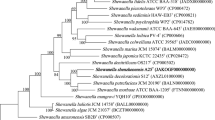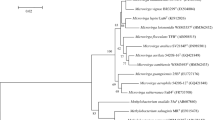Abstract
A novel arsenate-reducing bacterium, LY-1T, was isolated from freshwater sediment in Huangshi, China. Morphological analysis indicated that the cells were shaped like rods and were gram-negative. The major fatty acids (> 10%) were C16:0, summed feature 3 (C16:1 ω7c, C16:1 ω6c) and summed feature 8 (C18:1 ω7c, C18:1 ω6c). An assessment of the phylogeny based on 16S rRNA gene sequences indicated that the strain LY-1T belonged to the genus Citrobacter, while further analysis based on the recN gene indicated that LY-1T occupies a distinct phylogenetic niche within the Citrobacter genus. Moreover, average nucleotide identity and digital DNA-DNA hybridization between the strain LY-1T and the type strains of closely related species of the genus Citrobacter (C. europaeus, C. brakii, C. portucalensis, C. freundii, C. werkmanii, C. cronae, C. youngae, C. pasteurii, C. tructae, C. gillenii, and C. murliniae) were 85.8–93.8% and 31.2–56.9%, respectively. In addition, the LY-1T strain’s capacity to metabolize various compounds and its characteristic G + C content of 51.9% were also distinct from other species of the Citrobacter genus. These discriminatory features cumulatively indicate the LY-1T strain as a new species within the Citrobacter genus. We propose the species name Citrobacter arsenatis for this new species, with LY-1T (= CCTCC AB 2019169T = KCTC 72440T) as the type strain.


Similar content being viewed by others
Data availability
All data generated or analysed during this study are included in this published article (and its supplementary information files).
References
Borenshtein D, Schauer D (2006) The genus Citrobacter. In: Dworkin M, Falkow S, Rosenberg E, Scheleifer KH, Stackebrandt E (eds) The prokaryotes. Springer, New York, pp 90–98
Chun J, Rainey FA (2014) Integrating genomics into the taxonomy and systematics of the Bacteria and Archaea. Int J Syst Evol Microbiol 64:316–324
Clermont D, Motreff L, Passet V, Fernandez JC, Bizet C, Brisse S (2015) Multilocus sequence analysis of the genus Citrobacter and description of Citrobacter pasteurii sp. nov. Int J Syst Evol Microbiol 65:1486–1490
Fendorf S, Michael HA, van Geen A (2010) Spatial and temporal variations of groundwater arsenic in South and Southeast Asia. Science 328:1123–1127
Gao J, Zheng T, Deng Y, Jiang H (2017) Indigenous iron-reducing bacteria and their impacts on arsenic release in arsenic-affected aquifer in Jianghan plain. Earth Sci 42:716–726
Huang J, Sun Q, Yin C, Wang Y, Liu X (2017) Pyrosequencing reveals the effect of pesticide chlorpyrifos on soil bacterial diversity in greenhouse: a comparison with open field. Fresen Environ Bull 26:6324–6333
Kimura M (1980) A simple method for estimating evolutionary rates of base substitutions through comparative studies of nucleotide sequences. J Mol Evol 16:111–120
Kumar S, Stecher G, Li M, Knyaz C, Tamura K (2018) MEGA X: molecular evolutionary genetics analysis across computing platforms. Mol Biol Evol 35:1547–1549
Luo R, Liu B, Xie Y, Li Z, Huang W, Yuan J, He G, Chen Y, Pan Q, Liu Y et al (2012) SOAPdenovo2: an empirically improved memory-efficient short-read de novo assembler. GigaScience 1:18
Meier-Kolthoff JP, Auch AF, Klenk H, Göker M (2013) Genome sequence-based species delimitation with confidence intervals and improved distance functions. BMC Bioinform 14:60
Naum M, Brown EW, Mason-Gamer RJ (2008) Is 16S rDNA a reliable phylogenetic marker to characterize relationships below the family level in the Enterobacteriaceae? J Mol Evol 66:630–642
Ohtsuka T, Yamaguchi N, Makino T, Sakurai K, Kimura K, Kudo K, Homma E, Dong DT, Amachi S (2013) Arsenic dissolution from Japanese paddy soil by a dissimilatory arsenate-reducing bacterium Geobacter sp. OR-1. Environ Sci Technol 47:6263–6271
Oremland RS, Stolz JF (2003) The ecology of arsenic. Science 300:939–944
Osborne TH, McArthur JM, Sikdar PK, Santini JM (2015) Isolation of an arsenate-respiring bacterium from a redox front in an arsenic-polluted aquifer in West Bengal, Bengal Basin. Environ Sci Technol 49:4193–4199
Richter M, Rosselló-Móra R (2009) Shifting the genomic gold standard for the prokaryotic species definition. P Natl Acad Sci USA 106:19126–19131
Richter M, Rosselló-Móra R, Glöckner FO, Peplies J (2016) JSpeciesWS: a web server for prokaryotic species circumscription based on pairwise genome comparison. Bioinformatics 32:929–931
Ribeiro TG, Clermont D, Branquinho R, Machado E, Peixe L, Brisse S (2017a) Citrobacter europaeus sp. nov., isolated from water and human faecal samples. Int J Syst Evol Microbiol 67:170–173
Ribeiro TG, Gonçalves BR, da Silva MS, Novais Â, Machado E, Carrico JA, Peixe L (2017b) Citrobacter portucalensis sp. nov., isolated from an aquatic sample. Int J Syst Evol Microbiol 67:3513–3517
Ribeiro TG, Novais Â, Branquinho R, Machado E, Peixe L (2015) Phylogeny and comparative genomics unveil independent diversification trajectories of qnrB and genetic platforms within particular Citrobacter species. Antimicrob Agents Ch 59:5951–5958
Rodriguez-Lado L, Sun G, Berg M, Zhang Q, Xue H, Zheng Q, Johnson CA (2013) Groundwater arsenic contamination throughout China. Science 341:866–868
Saitou N, Nei M (1987) The neighbor-joining method: a new method for reconstructing phylogenetic trees. Mol Biol Evol 4:406–425
Saltikov CW, Cifuentes A, Venkateswaran K, Newman DK (2003) The ars detoxification system is advantageous but not required for As(V) respiration by the genetically tractable Shewanella species strain ANA-3. Appl Environ Microb 69(5):2800–2809
Samonis G, Karageorgopoulos DE, Kofteridis DP, Matthaiou DK, Sidiropoulou V, Maraki S, Falagas ME (2009) Citrobacter infections in a general hospital: characteristics and outcomes. Eur J Clin Microbiol 28:61–68
Sasser M (1990) Identification of bacteria by gas chromatography of cellular fatty acids. USFCC Newsl 20:1–6
Suhadolnik MLS, Salgado APC, Scholte LLS, Bleicher L, Costa PS, Reis MP, Dias MF, Ávila MP, Barbosa FAR, Chartone-Souza E, Nascimento AMA (2017) Novel arsenic-transforming bacteria and the diversity of their arsenic-related genes and enzymes arising from arsenic-polluted freshwater sediment. Sci Rep 7:11231
Tatusova T, DiCuccio M, Badretdin A, Chetvernin V, Nawrocki EP, Zaslavsky L, Lomsadze A, Pruitt KD, Borodovsky M, Ostell J (2016) NCBI prokaryotic genome annotation pipeline. Nucleic Acids Res 44:6614–6624
Tsuchiya T, Ehara A, Kasahara Y, Hamamura N, Amachi S (2019) Expression of genes and proteins involved in arsenic respiration and resistance in dissimilatory arsenate-reducing Geobacter sp. strain OR-1. Appl Environ Microbiol 85:e00763-e819
Wang J, Zeng X, Zhu X, Chen X, Zeng X, Mu Y, Yang Y, Wang Y (2017) Sulfate enhances the dissimilatory arsenate-respiring prokaryotes-mediated mobilization, reduction and release of insoluble arsenic and iron from the arsenic-rich sediments into groundwater. J Hazard Mater 339:409–417
Yamamura S, Amachi S (2014) Microbiology of inorganic arsenic: from metabolism to bioremediation. J Biosci Bioeng 118(1):1–9
Acknowledgements
This work was financially supported by Major Program of Technical Innovation Foundation of Hubei Province (2016ACA176), Research Foundation for Talented Scholars of HBPU (16xjz03R), Innovation Training Program in Hubei Province (201710920043), Science and Technology Research Project of Hubei Provincial Department of Education (B2016272), Science and Technology Research Project of HBPU (19XJK01Y) and Open Fund Project of Hubei Key Laboratory of Mine Environmental Pollution Control and Remediation (2013105)
Author information
Authors and Affiliations
Contributions
JH and HH conceived the study. HW performed the experiments. HW and JH analyzed the data, and HW, JH and HH drafted the manuscript. All authors have read and approved the manuscript.
Corresponding authors
Ethics declarations
Conflict of interest
The authors declare that they have no conflict of interest.
Ethical statement
I certify that this manuscript is original and has not been published and will not be submitted elsewhere for publication while being considered by Haobo Hou. And the study is not split up into several parts to increase the quantity of submissions and submitted to various journals or to one journal over time. No data have been fabricated or manipulated (including images) to support your conclusions. No data, text, or theories by others are presented as if they were our own. The submission has been received explicitly from all co-authors. And authors whose names appear on the submission have contributed sufficiently to the scientific work and therefore share collective responsibility and accountability for the results.
Additional information
Publisher's Note
Springer Nature remains neutral with regard to jurisdictional claims in published maps and institutional affiliations.
Supplementary Information
Below is the link to the electronic supplementary material.
Rights and permissions
About this article
Cite this article
Wang, H., Hou, H. & Huang, J. Citrobacter arsenatis sp. nov., an arsenate-reducing bacterium isolated from freshwater sediment. Antonie van Leeuwenhoek 114, 1285–1292 (2021). https://doi.org/10.1007/s10482-021-01601-y
Received:
Accepted:
Published:
Issue Date:
DOI: https://doi.org/10.1007/s10482-021-01601-y




